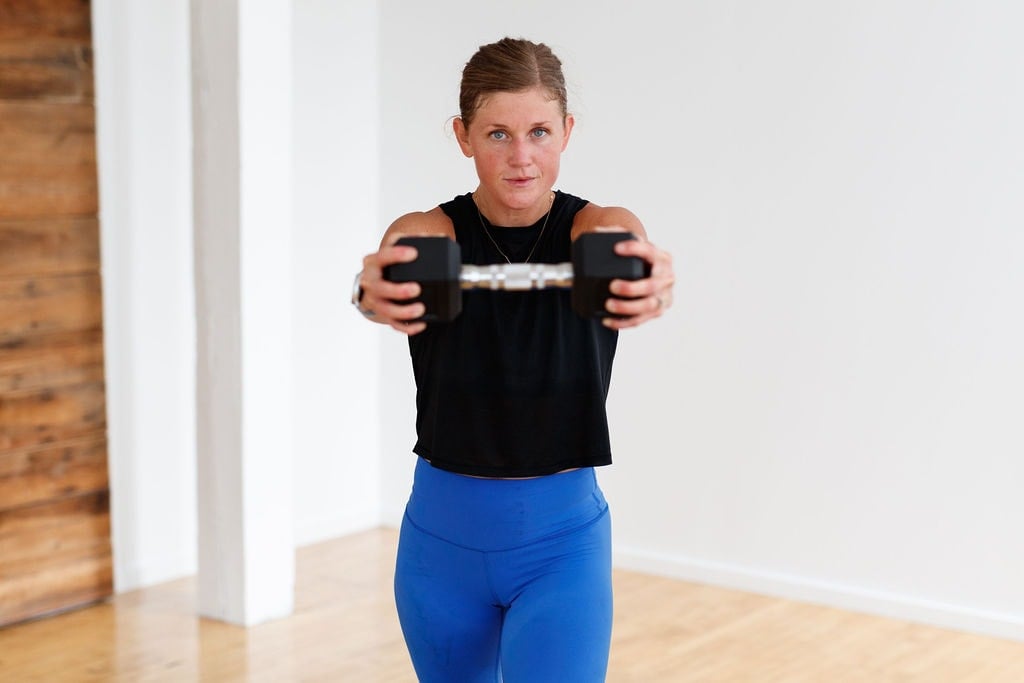Raise your heart rate and build strength with nine EMOM exercises. This full body EMOM workout pairs dumbbell strength and HIIT exercises to challenge your endurance. This workout can be adapted for all fitness levels; count your reps and work at your pace.
Our HIIT training home workout done in an EMOM format was so popular, I knew I had to create another workout in the same format.
“EMOM” stands for “every minute on the minute” and is one of my favorite formats because it’s efficient but super scalable. During an EMOM workout, you’re challenged to complete a specific number of reps in one minute of work time.
You control the intensity of the workout based on the weights you choose and the pace you work through your reps.
The combination of dumbbell strength exercises and HIIT cardio exercises in this EMOM workout encourages progressive overload.
You can lift heavy during the dumbbell strength exercises, increasing your bone density and building muscle mass. Then, push your pace during the HIIT cardio exercises to increase your VO2 max, improve cardiovascular health, increase endurance and burn fat.
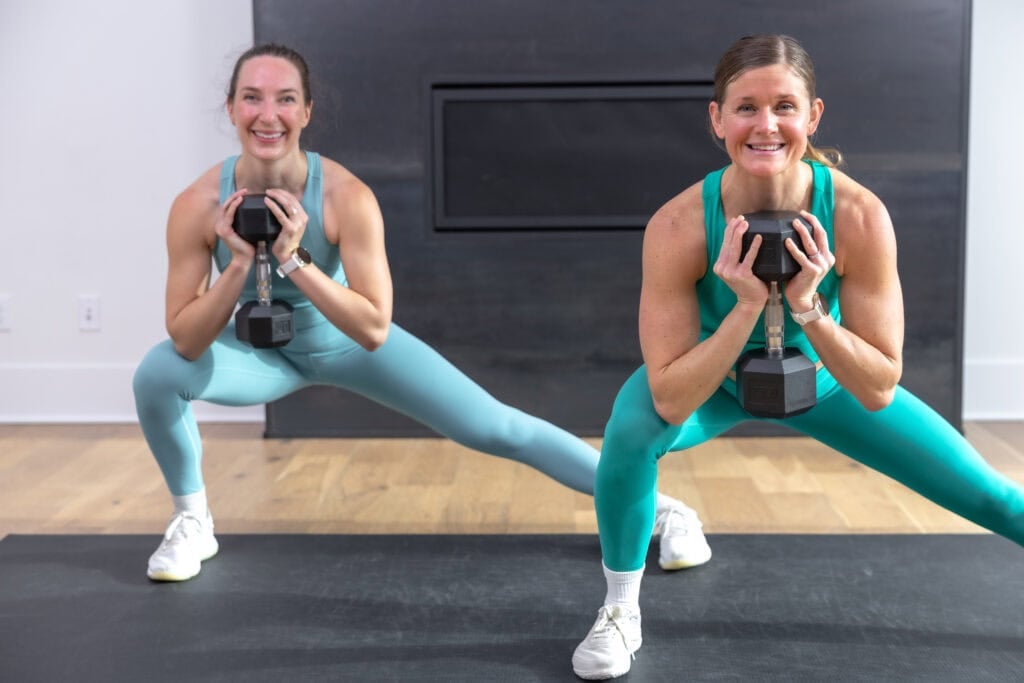

Benefits of EMOM Workouts
EMOM workouts push your rep-pace during the work time and teach your body to recover quickly with limited rest time. This format provides an efficient way to build muscle, strength and endurance in a short period of time.
35-Minute EMOM Workout
Get the benefits of both strength training and HIIT training at home with this effective dumbbell EMOM workout.
Add full body HIIT workouts like this to your HIIT program one to two times per week to increase total body strength and endurance.
Workout Instructions:
Follow along with the guided Full Body EMOM Workout on YouTube, led by certified personal trainer, Lindsey Bomgren.
Your Workout Looks Like This:
- 7 EMOM Circuits (EMOM = every minute on the minute)
- 2 Exercises/Circuit
- Repetition Based (each exercise will have a number of reps to complete; once you finish your reps, rest for the remaining part of the minute. The goal is to have at least 10 seconds rest at the end of each work block.)
- Repeat Each Circuit x3 Sets
Workout Equipment:
Medium-to-heavy set of dumbbells. We’re using 15-25 lbs. Optional pull up bar and long loop resistance band if needed (discount code: NML).
Workout Outline
CIRCUIT ONE:
- Heel Elevated Squat (10 Reps)
- Dumbbell Touch and Jack (10 Reps)
CIRCUIT TWO:
- Bicep Curl (10 Reps)
- Push Press (10 Reps)
CIRCUIT THREE:
- Curtsy Lunge (10 Reps)
- Skaters (20 Reps)
CIRCUIT FOUR:
- Pull Up (5 Reps)
- Push Up and Plank Jack (8 Reps)
CIRCUIT FIVE:
- Lateral Squat (10 Reps)
- Dumbbell Swing (15 Reps)
CIRCUIT SIX:
- Skull Crusher (10 Reps)
- Chest Fly Knee Tuck (8 reps)
CIRCUIT SEVEN:
- Squat Thruster (10 Reps)
- Burpee and Lateral Jump Over (5 Reps)
9 Best EMOM Exercises
1. Heel Elevated Squat
Targets: Legs, quads, glutes, hamstrings, inner thighs (hip abductors), chest and core.
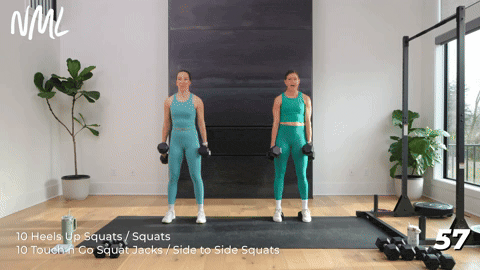

How To Do Heel Elevated Squats
- Place a set of dumbbells on the ground behind your feet. Stand with your feet hip width apart, placing your heels on the bar of each dumbbell. Hold two dumbbell by your sides. Engage your core.
- Inhale as you bend your knees and sit your hips back (as if sitting down in a chair). Aim for 90 degree bends at each knee, focusing on pushing your knees out (not letting them cave in). Keep your torso in an upright position.
- Exhale as you press through your heels to stand tall, driving your hips forward to return to the standing position.
Modification: Perform this move with feet flat on the floor if heels raised isn’t comfortable for you.
2. Dumbbell Touch and Jack
Targets: Legs, glutes, quads, hamstrings, outer glutes (side butt), inner thighs, calves and core.
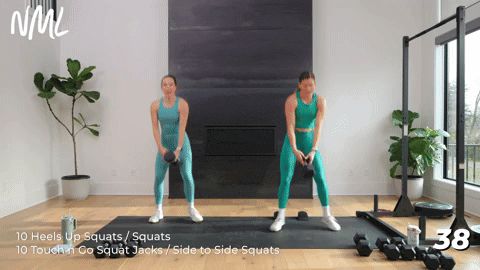

How To Do A Dumbbell Touch and Jack
- Start in an athletic stance or loaded squat position, with your feet shoulder-width distance apart and a slight bend in your knees. Hold one dumbbell in your left hand in front of you.
- With your chest upright and your core engaged, “jack” your feet out into a wide squat or sumo squat stance (feet are wider than your shoulders). As you jack your feet out, lower the dumbbell towards the ground.
- Land softly in a low squat, tapping the head of the dumbbell to the ground if you can.
- Then transfer the dumbbell to the opposite (right) hand as you “jack” your feet into a narrow stance. Feet are hip-width distance apart as you stand tall, pulling the dumbbell up and in line with your hips.
- Repeat, transferring the dumbbell to the opposite hand each time you perform a squat jack.
Modification: Option to omit the jump and step in and out. You can also make this a bodyweight exercise, omitting the dumbbell transfer.
3. Push Press
Targets: The deltoid muscles (shoulder muscles) and core.
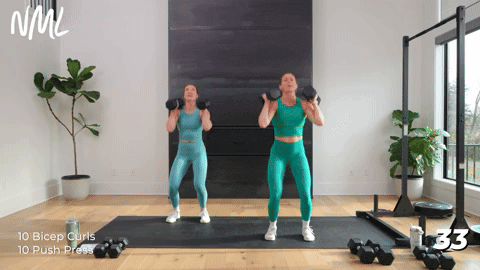

How To Do A Push Press
- Stand with feet shoulder-width distance apart, slight bend in your knees. Hold a pair of dumbbells at shoulder height, elbows pointing straight ahead and palms facing in towards each other (neutral grip).
- Drop into a shallow squat; about a two-inch dip. Then press through your heels, and push the dumbbells overhead until arms are fully extended, biceps by ears.
- Lower the dumbbells down to the starting position at shoulder-level.
4. Pull Up
Targets: Latissimus dorsi (lats), erector spinae, trapezius (traps), biceps, pectoralis major and minor (chest) and core.
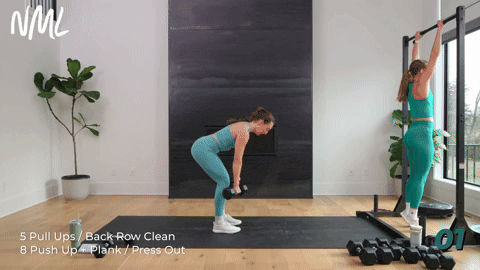

How To Do Pull Ups
- Start standing underneath your pull up bar, feet hip-width apart, neck and shoulders relaxed.
- Reach up and grip the pull-up bar with your palms facing away from your body (overhand grip), hands slightly wider than shoulder-width distance apart.
- Allow your body to hang freely with your arms fully extended.
- Initiate the pull up by squeezing your shoulder blades together and pulling your chest towards the bar. Keep your elbows pointed downward throughout the movement.
- Continue to pull your body, pulling your chest up until your chin is above the bar, or as high as you can comfortably go. Keep your core engaged and your body straight throughout the movement.
- Slowly lower yourself back down to the starting position, extending your arms fully.
Modification: Option to perform assisted pull ups with a long loop resistance band. Or, perform a dumbbell back row and clean (demonstrated on the left in the above image).
5. Push Up and Plank Jack
Targets: Upper body muscles – chest, shoulders, triceps, abs, core and inner and outer thigh muscles.
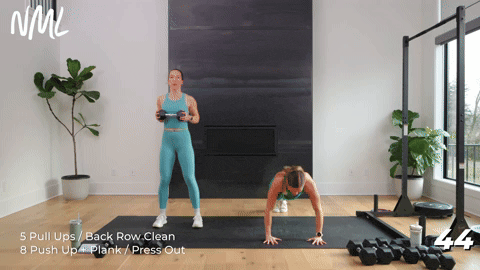

How To Do A Push Up and Plank Jack
- Start in a high plank position with your shoulders stacked over your wrists, weight evenly distributed amongst all 10 fingers. Pull your kneecaps up towards your belly, feet hip-width apart.
- Hold this plank position, maintaining a straight line with your body, gaze slightly in front of you.
- Lower your body down towards the mat, leading with your chest as you perform a push up. Elbows fall back towards your body.
- Once at the bottom of your push up, exhale as you push back up into high plank position
- Hold high plank as you “jack” your feet out wide, then jack them back to center, returning to the starting position.
- Repeat the sequence of one push up to one plank jack.
Modification: For a standing option, hold one dumbbell horizontally at your chest and perform an alternating overhead press to dumbbell press out, tapping the right and left toes out to the side as you alternate the dumbbell press.
6. Lateral Squat
Targets: Glutes (gluteus medius), quads, hip adductors (inner thighs), hamstrings and core.
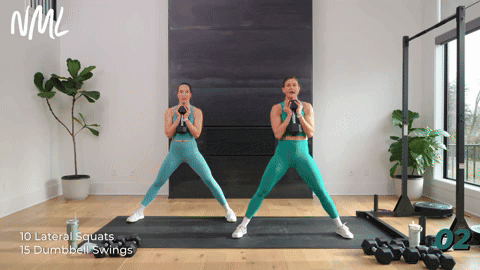

How To Do Lateral Squats
- Start standing, feet wider than shoulder-width (lateral squat stance), with toes facing forward or slightly turned out. Hold one dumbbell vertically at your chest in a goblet hold.
- Sit your hips back, bending your right knee while leaving your left leg straight. Think of performing a single leg squat with your right leg while your left leg remains straight.
- Then, drive off your right foot to reverse the movement, pushing back to center.
- Immediately push to the left side, bending your left knee while leaving your right leg straight. This time, think of performing a single leg squat with your left leg while your right leg remains straight.
7. Dumbbell Swing
Targets: The posterior chain (backside of the body) including the glutes, hamstrings, hips, core, and all the stabilizing muscles in your back and shoulders.
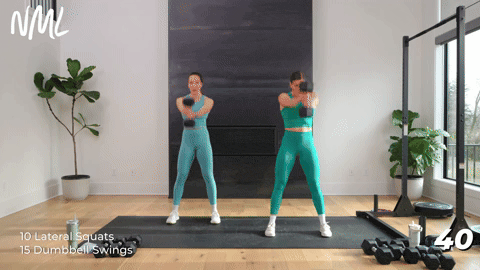

How To Do Dumbbell Swings
- Start standing with your feet wider than shoulder-width apart; engage your core. Hold one dumbbell, both hands stacked between the heads of the dumbbell and gripping the bar.
- With a slight bend in your knees and weight in your heels, hinge forward at the hips as you ‘hike’ the dumbbell back between your legs to start the swing movement.
- Drive through your heels to stand tall, pushing your hips forward as you squeeze your glutes to swing the weight up to shoulder height (full hip extension at the top). Aim for shoulder height, with arms extended out away from the body. Think long, loose arms (your arms are just a vehicle for moving the dumbbell, your hips and glutes generate the power to move the dumbbell).
- As the dumbbell begins to descend, think of catching the weight with your hip hinge movement, loading the glutes and hamstrings.
8. Squat Thruster
Targets: Legs, glutes, hamstrings, quads, hips, shoulders, abs and core.
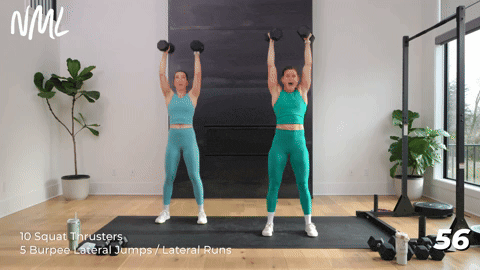

How To Do A Dumbbell Squat Thruster
- Start standing, feet shoulder-width apart, knees slightly bent. Hold one dumbbell in each hand. Dumbbells rests on your shoulders, in a front-racked position, overhand grip, palms facing in.
- With your weight in your heels, sit your hips back as you lower into a squat, striving for a 90-degree angle between your hips and knees.
- Then, drive through your heels, squeezing your glutes to stand tall. As you stand, perform an overhead thruster, pressing the dumbbells straight overhead. Your biceps should be near your ears.
- Bring the weights back down to shoulder height and repeat.
9. Burpee and Lateral Jump Over
Targets: Upper body (chest, arms, back, shoulders), lower body (legs, glutes, hips) and core.
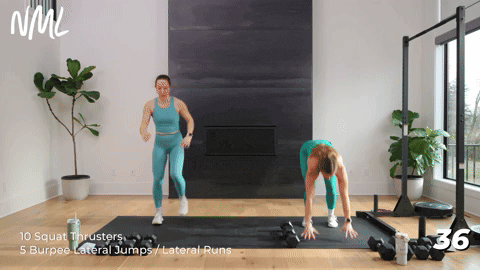

How To Do A Burpee and Lateral Jump Over
- Start standing, feet shoulder-width apart, arms at your sides. Option to place a dumbbell or two in the middle of your space. Position yourself so that you are standing to the right of the dumbbells.
- Bend your knees and drop your hips as you lower into a squat position, then place your hands on the floor directly in front of your feet.
- Shift your weight into your hands as you jump your feet back to softly land on the balls of your feet in a high plank position. Your body should form a straight line from your head to heels.
- Elbows fall back towards your body as you lower your chest towards the ground, bringing your chest to meet the floor. Press back up and return to high plank.
- Jump your feet up, landing outside your hands in a loaded squat position. Then drive through your legs to explode up. As you stand tall, jump laterally to the left and over the dumbbells, landing softly so that you’re now to the left of the dumbbells rather than to the right.
- Repeat the burpee and alternate your lateral hops throughout the timed interval.
Modification: Omit the burpee and perform a run in place and lateral hop.
FAQs
EMOM stands for “every minute on the minute.” An EMOM-style workout is a rep-based workout format that challenges you to work at your own pace by requiring you to perform the allotted number of repetitions of a particular exercise within 60 seconds or one minute of work. After completing your total reps, you rest for the remainder of the minute before moving onto the next exercise.
EMOM workouts are suitable for any fitness level because they allow you to work at your own pace. Beginners should start with lighter weights and modify exercises as needed. Don’t rush through your reps. Focus on form, considering quality over quantity.
Pin This Workout: 9 EMOM Exercises At Home
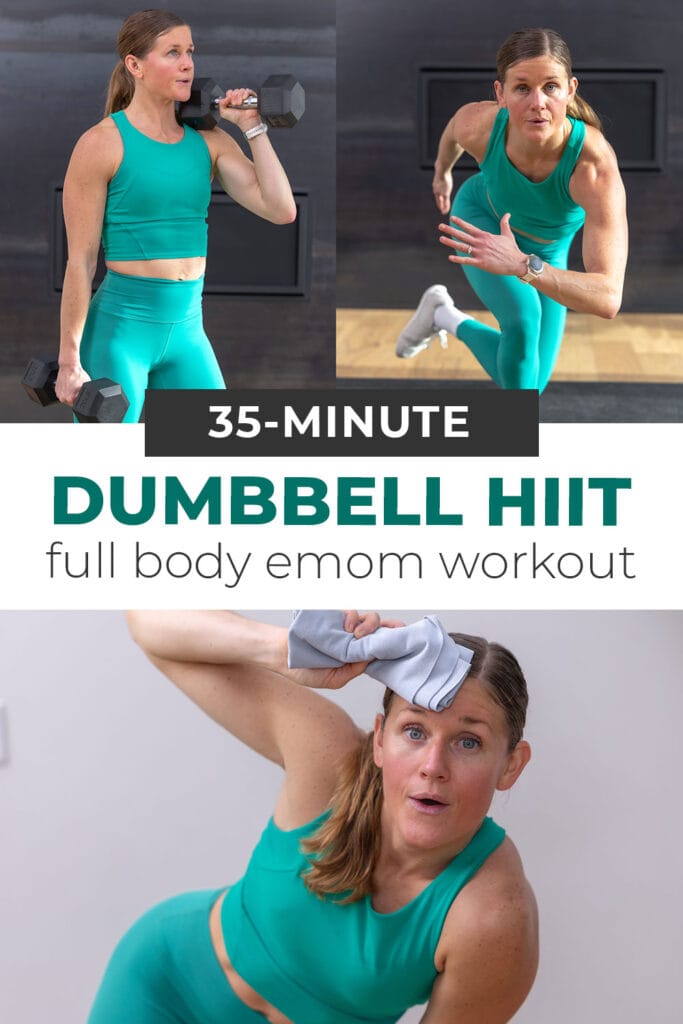

This post includes affiliate links. I do earn a commission for products purchased using these links (at no additional cost to you). Thank you for supporting Nourish Move Love, making the content you see on this blog possible.
















